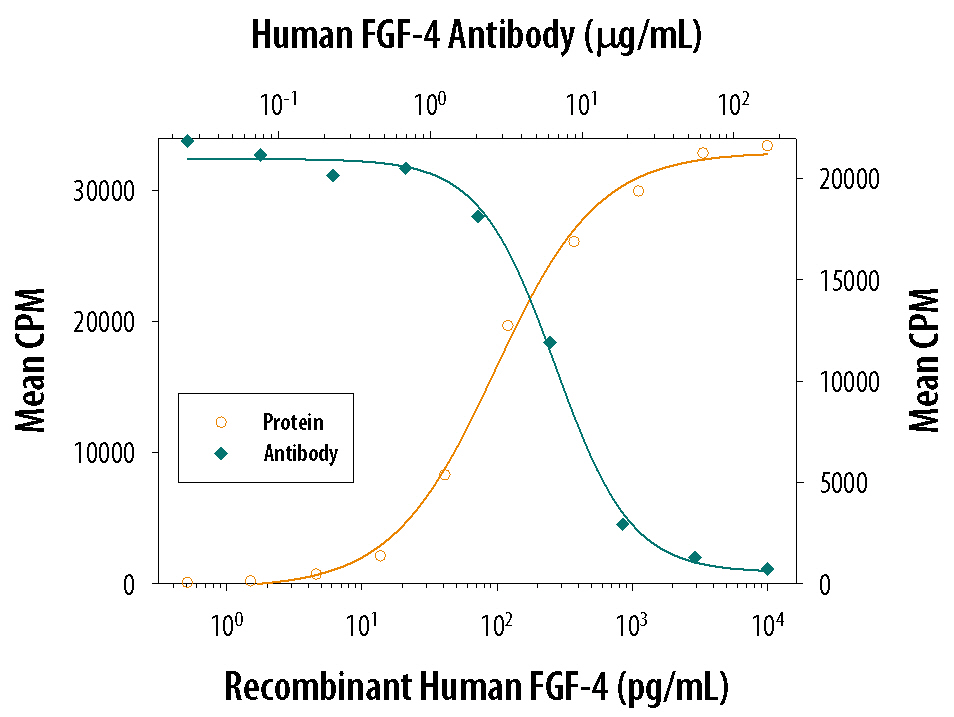Human FGF-4 Antibody Summary
Ala31-Leu206
Accession # P08620
Applications
Please Note: Optimal dilutions should be determined by each laboratory for each application. General Protocols are available in the Technical Information section on our website.
Scientific Data
 View Larger
View Larger
Cell Proliferation Induced by FGF‑4 and Neutralization by Human FGF‑4 Antibody. Recombinant Human FGF-4 (Catalog # 235-F4) stimulates proliferation in the NR6R-3T3 mouse fibroblast cell line in a dose-dependent manner (orange line). Proliferation elicited by Recombinant Human FGF-4 (0.5 ng/mL) is neutralized (green line) by increasing concentrations of Mouse Anti-Human FGF-4 Monoclonal Antibody (Catalog # MAB235). The ND50 is typically 5-8 µg/mL.
Reconstitution Calculator
Preparation and Storage
- 12 months from date of receipt, -20 to -70 °C as supplied.
- 1 month, 2 to 8 °C under sterile conditions after reconstitution.
- 6 months, -20 to -70 °C under sterile conditions after reconstitution.
Background: FGF-4
FGF-4, the product of a developmentally regulated gene (hst-1), is a member of the FGF family that is efficiently secreted. The gene for FGF-4 (also known as FGFK or K-FGF for Kaposi sarcoma-associated FGF) was initially discovered as a transforming gene by the NIH-3T3 focus formation assay using DNA derived from human tumors (including stomach and colon cancers, hepatocellular carcinomas, and Kaposi’s sarcomas). FGF-4 does not seem to be expressed in normal adult tissues. However, expression of the gene is spatially and temporally regulated during embryonic development. The murine homologue of human FGF-4 has been cloned and shown to be 82% homologous to the human protein at the amino acid sequence level. Human FGF-4 has been shown to exhibit cross species activity.
In vitro, FGF-4 is mitogenic for fibroblasts and endothelial cells. FGF-4 has been shown to be a potent angiogenesis promoter in vivo. FGF-4 has potent transforming potential apparently through an autocrine mechanism of action. FGF-4 plays a key role in limb development and has been identified as the molecular mediator of the activities of the apical ectodermal ridge that is required for directing the outgrowth and patterning of vertebrate limbs.
Product Datasheets
Citation for Human FGF-4 Antibody
R&D Systems personnel manually curate a database that contains references using R&D Systems products. The data collected includes not only links to publications in PubMed, but also provides information about sample types, species, and experimental conditions.
1 Citation: Showing 1 - 1
-
Heparin-binding secretory transforming gene (hst) facilitates rat lactotrope cell tumorigenesis and induces prolactin gene transcription.
Authors: Shimon I, Huttner A, Said J, Spirina OM, Melmed S
J. Clin. Invest., 1996-01-01;97(1):187-95.
Species: Rat
Sample Types: Cell Lysates, Whole Tissue
Applications: IHC-P, Immunoprecipitation
FAQs
No product specific FAQs exist for this product, however you may
View all Antibody FAQsReviews for Human FGF-4 Antibody
There are currently no reviews for this product. Be the first to review Human FGF-4 Antibody and earn rewards!
Have you used Human FGF-4 Antibody?
Submit a review and receive an Amazon gift card.
$25/€18/£15/$25CAN/¥75 Yuan/¥2500 Yen for a review with an image
$10/€7/£6/$10 CAD/¥70 Yuan/¥1110 Yen for a review without an image




